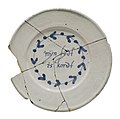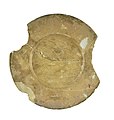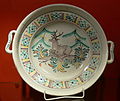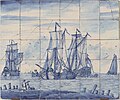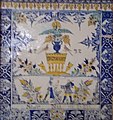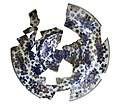Category:Faience
tin-glazed pottery | |||||
| Upload media | |||||
| Instance of | |||||
|---|---|---|---|---|---|
| Subclass of | |||||
| Named after | |||||
| Made from material |
| ||||
| Start time |
| ||||
| Different from | |||||
| |||||
The name "faïence" is simply the French name for Faenza, in the Romagna near Ravenna, Italy, where a painted majolica ware on a clean, opaque pure-white ground, emerged for export as early as the fifteenth century.
Faience or faïence is the conventional name in English for fine tin-glazed pottery on a buff earthenware body, at least when there is no more usual English name for the type concerned. The invention of a white pottery glaze suitable for painted decoration, by the addition of an oxide of tin to the slip of a lead glaze, was a major advance in the history of pottery. A kiln capable of producing temperatures exceeding 1,000 °C (1,830 °F) was required to achieve this result, the result of millennia of refined pottery-making traditions.
The term is now used for a wide variety of pottery from several parts of the world, including many types of European painted wares, often produced as cheaper versions of porcelain styles. Italian tin-glazed earthenware is often called maiolica in English, Dutch wares are called Delftware, and their English equivalents English delftware. "Faience" is the normal term in English for French, German, Spanish, Portuguese wares and those of other countries not mentioned.
Subcategories
This category has the following 15 subcategories, out of 15 total.
A
C
- Faience containers (58 F)
F
- Faience fragments (1 F)
I
- Islamic faience (48 F)
L
S
V
- Faïence violins (4 F)
📚
- Melitta 14-100 coffeemaker (24 F)
Media in category "Faience"
The following 181 files are in this category, out of 181 total.
-
1794 Schreibzeug anagoria.JPG 3,200 × 3,168; 6.66 MB
-
Abele Iacopi femme d'Abyssinie Lenci.png 480 × 800; 485 KB
-
Albert Anker - Jakob Böhm.jpg 746 × 750; 142 KB
-
Ansbacher Keramik 1.jpg 3,760 × 2,592; 6.2 MB
-
Assiette faience gien Saguez de Breuvery.jpg 2,889 × 3,059; 5.61 MB
-
Assiette girafe.jpg 1,050 × 1,050; 448 KB
-
Baksida av fajanstallrik, 1650-1700 - Skoklosters slott - 102362.tif 3,674 × 5,511, 2 pages; 115.91 MB
-
Baksida, Kopp med fat, 1800-tal. Fajans - Hallwylska museet - 90396.tif 5,616 × 3,744; 60.2 MB
-
Baksidan av tallrik från Persien, 1700-tal - Hallwylska museet - 99462.tif 5,616 × 3,744, 2 pages; 60.18 MB
-
Baksidan av tallrik från Persien, 1700-tal - Hallwylska museet - 99464.tif 5,616 × 3,744, 2 pages; 60.18 MB
-
Bibeloty.jpg 1,242 × 1,131; 372 KB
-
BischofBowle.png 291 × 300; 28 KB
-
Blommig tekanna av fajans gjord på 1600-talet - Skoklosters slott - 93592.tif 3,744 × 5,616; 60.17 MB
-
BLW Dish (2).jpg 2,426 × 2,400; 1.79 MB
-
Bord in faience, collectie Raakvlak, 94001-1-10B-44.jpg 6,167 × 6,172; 5.68 MB
-
Bord in faience, collectie Raakvlak, 94001-1-10B-45.jpg 6,698 × 6,376; 6.31 MB
-
Bord in faience, collectie Raakvlak, BR-L.V.-89.jpg 5,306 × 5,283; 5.39 MB
-
Bord in faience, collectie- Raakvlak, 93007-1-10-A-1.jpg 4,125 × 4,779; 2.58 MB
-
Bord in faience, collectie- Raakvlak, 93007-1-10-A-2.jpg 5,609 × 3,961; 2.86 MB
-
Bord in faience, collectie- Raakvlak, 93007-1-10-A-3.jpg 4,540 × 5,426; 3.14 MB
-
Bord in faience, collectie- Raakvlak, 93007-1-10-A-4.jpg 3,937 × 3,997; 2.56 MB
-
Bord in faience, collectie- Raakvlak, 93007-1-10-A-5.jpg 3,549 × 3,717; 1.61 MB
-
Bord in faience, collectie- Raakvlak, 94001-1-10B-42.jpg 5,509 × 5,421; 4.79 MB
-
Bord in faience, collectie- Raakvlak, 94001-1-10B-43.jpg 6,698 × 6,745; 6.93 MB
-
Bord in faience, collectie- Raakvlak, BR11-PRED-1-40-A-10.jpg 2,084 × 2,480; 1.38 MB
-
Bord in faience, collectie- Raakvlak, BR14-EZ-1-4-A-69.jpg 4,549 × 4,393; 4.83 MB
-
Bord in faience, collectie- Raakvlak, BR14-EZ-1-4-A-72.jpg 6,000 × 3,261; 4.22 MB
-
Bord in faience, collectie- Raakvlak, BR89-WOK-1-1-A-10.jpg 6,000 × 4,000; 5.89 MB
-
Bord in faience, collectie- Raakvlak, BR89-WOK-1-1-A-11.jpg 4,277 × 4,269; 5.61 MB
-
Bord in faience, collectie- Raakvlak, BR89-WOK-1-1-A-13.jpg 4,148 × 4,376; 4.86 MB
-
Bord in faience, collectie- Raakvlak, BR89-WOK-1-1-A-7.jpg 4,481 × 4,360; 4.56 MB
-
Bord in faience, collectie- Raakvlak, BR89-WOK-1-1-A-8.jpg 4,589 × 4,517; 6 MB
-
Bord in faience, collectie- Raakvlak, BR90-GAR-1-1-A-47.jpg 6,000 × 4,000; 9.15 MB
-
Bord in faience, collectie- Raakvlak, BR90-WI-1-55-14.jpg 6,184 × 6,211; 5.4 MB
-
Bord in faience, collectie- Raakvlak, BR90-WI-1-55-9.jpg 6,000 × 4,000; 3.92 MB
-
Bord in faience, collectie- Raakvlak, BR99-J-1B-367.jpg 5,046 × 4,936; 6.16 MB
-
Brush holder, 1661-1722, Chinese, faience, Honolulu Museum of Art.JPG 1,257 × 1,326; 179 KB
-
Bursa Yeşil Camii - Green Mosque (13).jpg 3,024 × 4,032; 2.46 MB
-
Bursa Yeşil Camii - Green Mosque (14).jpg 3,024 × 4,032; 1.77 MB
-
Bursa Yeşil Camii - Green Mosque (15).jpg 4,032 × 3,024; 4.16 MB
-
Bursa Yeşil Camii - Green Mosque (16).jpg 4,032 × 3,024; 3.18 MB
-
Bursa Yeşil Camii - Green Mosque (17).jpg 4,032 × 3,024; 3.22 MB
-
Bistrushkin servis dachnii cvet.jpg 900 × 683; 329 KB
-
Bistrushkin suharnitsi.jpg 1,000 × 375; 220 KB
-
Chaumont04.jpg 3,684 × 2,848; 6.53 MB
-
Colonne BARBOTINE Saint-Clément.jpg 500 × 500; 109 KB
-
Desvres musee de ceramique Salière, Jules Fourmaintraux, eind 19e eeuw.jpg 2,800 × 3,200; 4.39 MB
-
Detail of chancel wall covering - Trent - geograph.org.uk - 1418516.jpg 640 × 480; 139 KB
-
Ephraim Faience Pottery.JPG 3,264 × 2,448; 1.26 MB
-
Eulenpokal-Stadt-Schaffhausen-Fayence-16Jhr.jpg 1,101 × 1,913; 435 KB
-
Faience Fish Dish excavated at Abydos 1551-1307 BCE Dynasty 18 Egypt Penn Museum.jpg 3,412 × 2,796; 1.07 MB
-
Faience Plate Traditional.jpg 1,896 × 1,728; 445 KB
-
Fajans fat, 1600-talets sista hälft - Skoklosters slott - 102325.tif 5,616 × 3,744, 2 pages; 60.18 MB
-
Fajans-wloclawek-kobaltowe-wzory.jpg 4,608 × 2,184; 2.88 MB
-
Fajansfat från 1600-talet med blå underglasyrmålning - Skoklosters slott - 93595.tif 5,616 × 3,744; 60.17 MB
-
Fajansfat från 1860-180 med blå blomsterranka i underglasyrtryck - Skoklosters slott - 93454.tif 5,616 × 3,744; 60.17 MB
-
Fajansfat från 1860-180 med blå blomsterranka i underglasyrtryck - Skoklosters slott - 93457.tif 5,616 × 3,744; 60.17 MB
-
Fajansfat med blå kinesiserande underglasyrmålning - Skoklosters slott - 93320.tif 5,616 × 3,744; 60.17 MB
-
Fat av fajans med blå kinesiserande underglasyrmålning - Skoklosters slott - 93324.tif 5,616 × 3,744; 60.17 MB
-
Fat av fajans med blå kinesiserande underglasyrmålning - Skoklosters slott - 93330.tif 5,616 × 3,744; 60.17 MB
-
Fat av fajans med blå underglasyrmålning, från 1650-1700 - Skoklosters slott - 93331.tif 5,616 × 3,744; 60.17 MB
-
Faïence Lithocérane de Briare vers 1840.JPG 1,830 × 1,290; 269 KB
-
Flat tallrik av vitglaserad fajans från 1600-talet - Skoklosters slott - 93586.tif 5,616 × 3,744; 60.17 MB
-
Flat tallrik av vitglaserad fajans från 1600-talet - Skoklosters slott - 93587.tif 5,616 × 3,744; 60.17 MB
-
Flat tallrik av vitglaserad fajans från 1600-talet - Skoklosters slott - 93588.tif 5,616 × 3,744; 60.17 MB
-
Flat tallrik av vitglaserad fajans från 1600-talet - Skoklosters slott - 93589.tif 5,616 × 3,744; 60.17 MB
-
Fukakusa Ware, Faience Ware and Arita Porcelain (4788319216).jpg 3,040 × 2,276; 448 KB
-
Green Tomb - Yeşil Türbe (1).jpg 4,032 × 3,024; 3.64 MB
-
Green Tomb - Yeşil Türbe (10).jpg 4,032 × 3,024; 3.14 MB
-
Green Tomb - Yeşil Türbe (14).jpg 3,802 × 2,850; 3.68 MB
-
Green Tomb - Yeşil Türbe (18).jpg 4,032 × 3,024; 3.12 MB
-
Guingot-chardonneret bruant par la faïencerie de Saint-Clément.jpg 2,112 × 1,146; 686 KB
-
Hemutst 1917 Wilhelm Kage.jpg 1,750 × 1,114; 374 KB
-
4672 - Brescia - S. Giulia - Ceramiche antiche - Foto Giovanni Dall'Orto, 25 Giu 2011.jpg 1,936 × 1,288; 1.22 MB
-
Jahangir Mausoleum10.jpg 1,024 × 768; 432 KB
-
KMO - Ofenkachel Köln.jpg 3,576 × 2,916; 6.89 MB
-
KMO - Ofenkachel Wintherthur 1.jpg 2,264 × 3,208; 4.49 MB
-
KMO - Ofenkachel Wintherthur 2.jpg 2,706 × 3,459; 6.06 MB
-
KMO - Ofenkachel Wintherthur 3.jpg 1,562 × 3,905; 3.91 MB
-
Lavabo .jpg 2,481 × 3,509; 1.88 MB
-
Le petit joueur de cornemuse (V&A Museum) (12050371136).jpg 683 × 1,024; 300 KB
-
Lotfollah mosque, isfahan.jpg 1,200 × 2,200; 1.43 MB
-
Lévrier art déco de Charles Lemanceau.jpg 1,152 × 1,728; 653 KB
-
Majolika1.JPG 893 × 1,591; 180 KB
-
Malicorne, faïencerie (14).jpg 3,888 × 2,592; 3.69 MB
-
ML - Fayence Hirsch.jpg 2,008 × 1,692; 784 KB
-
Moravská galerie 18 - Kamna detail.JPG 2,592 × 3,888; 8.01 MB
-
Mosaik Cottbusser Str 23 (Helld) Wolfgang-Amadeus-Mozart-Schule.jpg 4,813 × 2,465; 8.7 MB
-
Mouleurs en 1892, faïencerie de Lunéville..jpg 5,275 × 3,517; 13.44 MB
-
Museu Quinta das Cruzes, Funchal (4) - Oct 2010.jpg 2,304 × 3,072; 467 KB
-
Muzeum Historii Miasta Poznania 19.jpg 4,000 × 3,000; 2 MB
-
Mísa, 1610.jpg 2,481 × 3,509; 2.46 MB
-
Old Petersburg exposition 02.JPG 2,112 × 2,816; 6.15 MB
-
Panneau de 30 Carreaux, Cornelis Boomeester.jpg 688 × 575; 92 KB
-
Paul Lecomte Malicorne.jpg 412 × 733; 55 KB
-
Peintres 1892, faïencerie de Lunéville.jpg 5,181 × 3,454; 12 MB
-
Petite sous-tasse en Faïence de madame Desmette - Maison Léon Losseau.jpg 5,286 × 4,010; 19.87 MB
-
Petite tasse en Faïence de madame Desmette - Maison Léon Losseau.jpg 4,686 × 3,167; 9.88 MB
-
Petite tasse et sous-tasses en Faïence de madame Desmette - Maison Léon Losseau.jpg 5,725 × 3,473; 13.84 MB
-
Plate-museum collection.JPG 3,456 × 2,304; 3.81 MB
-
Podnos na nožce, 1607.jpg 2,481 × 3,509; 1.73 MB
-
Podnos na nožce.jpg 2,481 × 3,509; 1.91 MB
-
Poste centrali firenze cupoletta.JPG 2,592 × 1,944; 2.47 MB
-
Pote com as Armas Franciscanas, c. 1650.jpg 432 × 496; 59 KB
-
Potta från mitten av 1700-talet, gjord av fajans med blomrankor - Skoklosters slott - 95297.tif 5,130 × 3,594; 20.08 MB
-
Ram merk Frits van Beest.jpg 949 × 1,000; 201 KB
-
Ram, advertentie, 1926.jpg 648 × 766; 234 KB
-
Reczne-malowanie-perel-fajansowelove.jpg 3,913 × 1,904; 2.23 MB
-
Revival of the famous faience work in Jerusalem. Decorating a vase. LOC matpc.05666.jpg 5,678 × 4,253; 2.39 MB
-
Rothenburg Museum - Chanukkaleuchter.jpg 3,508 × 2,640; 5.63 MB
-
RoyalCphFajMark.jpg 271 × 600; 28 KB
-
Rudnyánszky mansion. R 15. Rococo faience stove, 18th c. - Budapest.JPG 2,448 × 3,264; 1.85 MB
-
Rudnyánszky mansion. R 17. Stove, mid 18th c. - Budapest.JPG 2,448 × 3,264; 1.81 MB
-
Rudnyánszky mansion. R 19. Stove (19th cent.). - Budapest.JPG 2,448 × 3,264; 1.86 MB
-
Rudnyánszky mansion. R 26. Stove, mid 18th c. - Budapest.JPG 2,448 × 3,264; 1.83 MB
-
Satsuma Faience (4788324058).jpg 3,290 × 2,107; 819 KB
-
Schaal, collectie Raakvlak, 94001-1-10-118.jpg 7,287 × 6,357; 7.55 MB
-
Schale mit flötendem Jungen KGM 1986-118.jpg 2,677 × 2,140; 3.27 MB
-
Sheikh Lotf Allah Mosque Isfahan 001.jpg 1,200 × 1,900; 903 KB
-
Signatur på undersida av fajans, från 1650-1700 - Skoklosters slott - 93334.tif 5,616 × 3,744, 2 pages; 60.17 MB
-
Signerad undersida på fajans från 1650-1700 - Skoklosters slott - 93338.tif 5,616 × 3,744; 60.17 MB
-
SIMS Campus - Entarence.jpg 3,000 × 2,000; 3.42 MB
-
Sköljfat-durkslag av vitglaserad fajans från 1700-talets mitt - Skoklosters slott - 93590.tif 5,616 × 3,744; 60.17 MB
-
Sköljfat-durkslag av vitglaserad fajans från 1700-talets mitt - Skoklosters slott - 93591.tif 5,616 × 3,744; 60.17 MB
-
Soudek, 1607..jpg 2,481 × 3,509; 1.75 MB
-
Sous-tasse en Faïence de madame Desmette - Maison Léon Losseau.jpg 5,202 × 4,010; 18.97 MB
-
Stekfat av vitglaserad fajans, från 1600-talet - Skoklosters slott - 93577.tif 5,616 × 3,744, 2 pages; 60.17 MB
-
Stekfat av vitglaserad fajans, från 1600-talet - Skoklosters slott - 93579.tif 5,616 × 3,744; 60.17 MB
-
Stekfat av vitglaserad fajans, från 1600-talet - Skoklosters slott - 93580.tif 5,616 × 3,744; 60.17 MB
-
Sygnatura. Fabryka Fajansu Włocławek.jpg 3,200 × 5,185; 11.2 MB
-
Tallrik från Persien, 1400-tal - Hallwylska museet - 99456.tif 5,616 × 3,744, 2 pages; 60.18 MB
-
Tallrik från Persien, 1700-tal - Hallwylska museet - 99461.tif 5,616 × 3,744, 2 pages; 60.18 MB
-
Tallrik från Persien, 1700-tal - Hallwylska museet - 99463.tif 5,616 × 3,744, 2 pages; 60.18 MB
-
Tasse en Faïence de madame Desmette - Maison Léon Losseau.jpg 6,014 × 4,010; 15.66 MB
-
Tasse et sous-tasse en Faïence de madame Desmette (2).jpg 6,000 × 4,000; 9.68 MB
-
Tasse et sous-tasse en Faïence de madame Desmette (3).jpg 6,000 × 4,000; 9.28 MB
-
Tasse et sous-tasse en Faïence de madame Desmette.jpg 6,000 × 4,000; 9.04 MB
-
Tasse et sous-tasses en Faïence de madame Desmette - Maison Léon Losseau.jpg 6,014 × 4,010; 11.13 MB
-
Tata faience earthernware (UBC-2009).jpg 3,264 × 2,448; 889 KB
-
TeedoseLesum.jpg 1,774 × 2,500; 912 KB
-
Tegel in faience, collectie Raakvlak, BR90-GAR-2-L.V.-A-60.jpg 4,000 × 3,000; 2.04 MB
-
Tegel in faience, collectie Raakvlak, BR99-J-1B-521a.jpg 4,326 × 4,450; 7.75 MB
-
Tegel in faience, collectie Raakvlak, BR99-J-1B-521b.jpg 4,335 × 3,709; 5.59 MB
-
Terrine Aumund.jpg 1,200 × 991; 801 KB
-
The Australian flora in applied art BHL7371613.jpg 3,568 × 2,342; 843 KB
-
The Intrepid Fox faience relief.jpg 2,250 × 3,376; 4.08 MB
-
Tile art at Wazir khan Mosque.jpg 1,495 × 1,932; 742 KB
-
Toiletthink med försänkt lock och sil, 1875-1899 - Skoklosters slott - 108358.tif 8,688 × 5,792; 144 MB
-
Turkey.faience01.jpg 2,048 × 1,536; 1.68 MB
-
Turkey.faience02.jpg 2,048 × 1,536; 1.29 MB
-
Undersidan av vas, 1700-tal - Skoklosters slott - 99453.tif 5,616 × 3,744, 2 pages; 60.18 MB
-
Ushe, Fruktskål, 1800-tal - Hallwylska museet - 90450.tif 3,744 × 5,616; 60.2 MB
-
Wijwatervat in faience, collectie Raakvlak, BR99-J-1B-384.jpg 3,503 × 4,256; 5.69 MB
-
Wijwatervat in faience, collectie Raakvlak, BR99-J-1B-385.jpg 4,000 × 6,000; 5.04 MB
-
WLANL - Effeietsanders.wla - bord.jpg 1,024 × 768; 349 KB



















